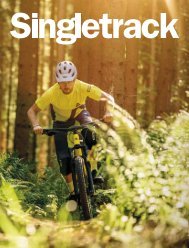Create successful ePaper yourself
Turn your PDF publications into a flip-book with our unique Google optimized e-Paper software.
uk classics<br />
The Skull E4 6a<br />
Diffwys Ddu (Cyrn Las) North Wales<br />
A Welsh mountain classic by Keith Sharples<br />
ROUTE LOCATION FIRST ASCENT<br />
The Skull (E4 4a, 4b, 5c, 6a, 5c) Diffwys Ddu (Cyrn Las), North Wales M Boysen, A Williams, J Jordan 1966<br />
with aid. FFA: R Evans, H Pasquill 1974<br />
Paul Reeves leading the rightward hanging groove line<br />
on the fifth pitch of The Skull (E4 4a, 4b, 5c, 6a, 5c) on<br />
Cyrn Las, Llanberis Pass. Photo: Keith Sharples<br />
Seen from the Ynys Ettws, The <strong>Climber</strong>s’ Club<br />
hut in Llanberis Pass, Diffwys Ddu looms high<br />
on the mountainside above Cwm Glas. Early<br />
climbers, for reasons unknown, nicknamed the<br />
crag Cyrn Las – a name which it has retained<br />
ever since. Viewed through the murkiness of<br />
inclement weather, Cyrn Las has a threatening<br />
presence; an appearance that it fails to lose<br />
even in bright early morning sunlight when<br />
crags usually have a friendly persona. Paradoxically,<br />
early morning sunlight gifts Cyrn Las an<br />
even more ominous appearance as deep<br />
shadows appear high on the headwall creating<br />
what appear to be pair of deeply sunken eye<br />
sockets. Seen through the furtive imagination<br />
of someone about to climb The Skull, it’s easy<br />
to imagine some monster peering out keeping<br />
a check on those below.<br />
Incredibly, it’s 51 years since Martin Boysen<br />
did the first ascent of The Skull. According to the<br />
guidebook he used six points of aid; this was<br />
eliminated in 1974 by Ray Evans and Hank Pasquill.<br />
Save for a passing mention in the final chapter,<br />
Boysen barely even mentions his ascent of The<br />
Skull in his own autobiography, Hanging On,<br />
‘I loved our days on Dinas Mot, and climbing<br />
The Skull on the overhanging prow of Cryn Las<br />
with Jud Jordan’. Hardly a big sell for one of the best<br />
mountain E4s in the country. But given Boysen’s<br />
climbing CV which is rammed with diamonds from<br />
the Alps to the Himalaya, perhaps we can forgive<br />
him for glossing over The Skull. Boysen was equally<br />
self-deprecating when David Jones asked him about<br />
doing first ascents when he interviewed him for<br />
The Power of Climbing, ‘I’ve tended to pick off the<br />
odd first ascent here and there if it’s come fairly<br />
easily…’ Well pick up a Welsh guidebook and<br />
fact check that some time and you find Boysen’s<br />
name crops up repeatedly around that era mixing<br />
it up with the leading rock stars of the day. Make<br />
no mistake, however, The Skull is a Welsh<br />
diamond from one of the top climbers of his day.<br />
A particularly hot spell of weather in late May<br />
this year seemed the perfect opportunity to address<br />
the wrong that I’d woefully allowed to gather<br />
momentum; namely that I’d not climbed on Cyrn<br />
Las, let alone done The Skull. This, despite having<br />
both on my list of ‘must do’s’ since the early 80s.<br />
Like refugees from a boiling cauldron, Paul and<br />
I typically run away from the white heat of<br />
Malham whenever it becomes too hot. Bent<br />
on picking off classic mountain trad routes if<br />
possible; we are nothing but Extreme Rock<br />
whores. And that was exactly what presented the<br />
biggest challenge of all, would The Skull be too<br />
big a challenge for a pair of sport climbers – one<br />
of whom (the writer) hadn’t placed a nut in anger<br />
in two years. A simplistic solution – yet one<br />
which we hoped had some merit – was that we’d<br />
call into New Mills Tor on the drive over to The<br />
Pass from Sheffield and get into the trad groove.<br />
And that we did, successfully negotiating some<br />
of New Mills’ finest before we headed off west.<br />
It was hardly the ideal prep for a multi-pitch<br />
mountain but that was our only option.<br />
Cometh the morning, the sun duly shone,<br />
it was truly glorious in The Pass. There was no<br />
backing out now, but at least we couldn’t have<br />
asked for better weather. For 45 minutes or so<br />
walking in I imagined the Cyrn Las monster<br />
keeping tabs on us as we approached. The<br />
walk-in and easy approach scramble finally<br />
completed we geared up beneath the crag. In<br />
truth, the first two pitches were pretty scrappy,<br />
they detracted rather than added to the route.<br />
Taking an obvious shortcut we were soon on the<br />
second stance and below all difficulties. By some<br />
fluke I’d finished up with the lead of the first hard<br />
pitch; a short but reputedly tough little crack. I’ve<br />
always liked the security of climbing cracks, the<br />
lure of decent gear proving overwhelmingly<br />
irresistible. Strangely, I always seem to forget<br />
that hard cracks are typically pumpy affairs, a fact<br />
I was reminded of as soon as I got to grips with<br />
it. A couple of good cams and a swift move or<br />
two and the pitch was as good as over. The<br />
climbing hadn’t been as exacting as I’d imagined<br />
it might but that pitch has wreaked considerable<br />
pain and grief in the past for one climber at least,<br />
a large loose flake dislodged under his weight<br />
and fell to the screes below taking the majority of<br />
his fingers from one hand with it. I had been well<br />
aware of this gruesome incident but hadn’t<br />
appreciated until later that it was exactly 20 years<br />
to that very day of our ascent that the accident<br />
had happened. It’s a sobering reminder that rock<br />
on mountain routes isn’t always to be trusted.<br />
Meanwhile back at the belay, I had an<br />
excellent view, rather too good, in fact, of the<br />
fourth pitch. Hanging over the by now gathering<br />
void, the way ahead took a hanging arête on<br />
what appeared the very edge of nowhere.<br />
Honestly, I was more than happy that it was<br />
Paul’s lead. It was, just as Nick Bullock had said<br />
to us earlier that morning in the car park, short<br />
but pokey with hard-won gear and decent if<br />
sharp holds. The yawning void beneath was<br />
completely ignored by Paul – probably the best<br />
approach in reality. Seconding it was a joy;<br />
pulling on holds and ripping gear out as fast<br />
as possible, and what exposure. And yes, the<br />
loose-looking flake does take bodyweight.<br />
The stance above was really quite resplendent,<br />
a good flake, some excellent mid-sized cams and<br />
an even better view of The Pass by now falling<br />
away beneath us. Paul had his eye in by now and<br />
was soon ensconced in the rightward hanging<br />
groove line that was the meat of the fifth and final<br />
pitch. His rapid and exuberant progress soon came<br />
to an abrupt halt, however, progress thereafter<br />
seemed slow – a classic two moves up and one<br />
move back shuffle. How hard could it be I mused?<br />
All too soon I got the perfect opportunity to find<br />
out. Graham Hoey, a good friend, had tipped me<br />
the nod that the final pitch involved wide bridging<br />
so I rather smugly set off to show it who was the<br />
boss. I can generally bridge as well as the next<br />
climber but the crucial section of that top pitch<br />
is more than bridging, not least because there’s<br />
only two footholds in the entire length of the final<br />
groove. Think 3D though and look behind you and<br />
when in doubt squirm a lot as well. Fortunately,<br />
for Paul it was well-protected; fortunately for me<br />
I was seconding and my eyesight is now that bad<br />
I couldn’t see the humongous drop beneath me.<br />
Long story short, it’s a fantastic route, without<br />
a doubt one of the great Welsh mountain classics.<br />
I’m sure it would have felt easier had we been<br />
more in the trad groove but in all honesty we<br />
couldn’t tell the pitches apart – they all felt like<br />
6a rather than the 5c, 6a, 5c that the guide has<br />
historically given them. And if Nick Bullock<br />
figures they’re all worth 6a, I for one won’t<br />
disagree with him. n<br />
16 Sep–Oct <strong>2017</strong> www.climber.co.uk






